Waterproof Paint for Bathrooms: Essential Insights
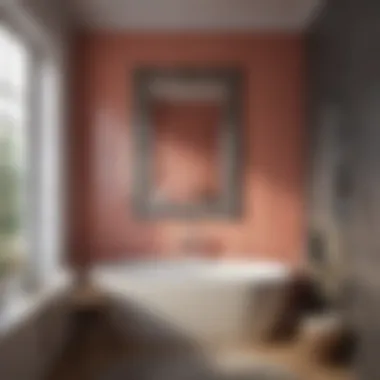
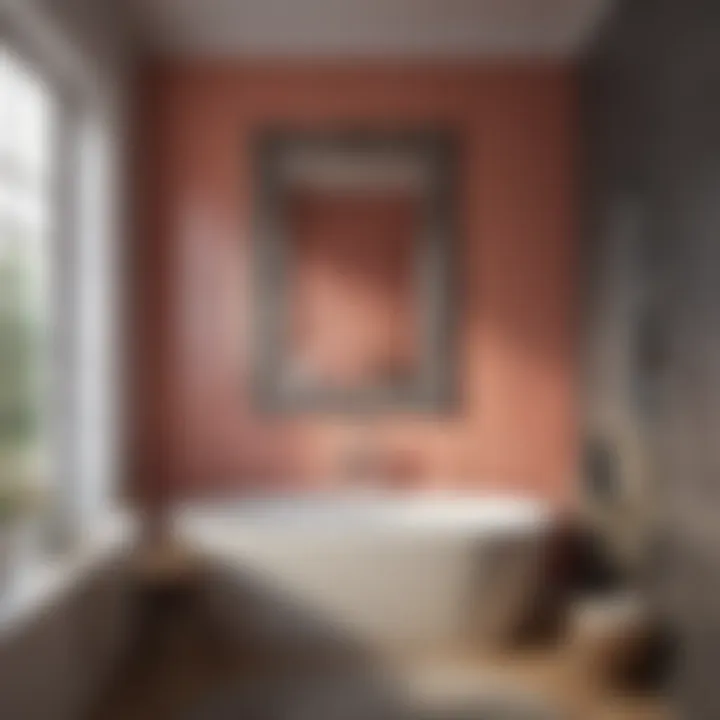
Intro
Bathrooms are an oasis of tranquility in our homes, but they come with their unique set of challenges, particularly when it comes to moisture. The constant steam from showers and the high humidity levels can wreak havoc on conventional paint. Therefore, investing in waterproof paint is not just a matter of aesthetic appeal but also an essential aspect of maintaining a healthy and durable bathroom environment. This guide aims to equip homeowners, renters, and design aficionados with the knowledge to navigate the world of waterproof paints, making informed choices that enhance both functionality and style.
In this article, we'll explore various types of waterproof paint, their benefits and setbacks, and application techniques that ensure longevity. Furthermore, we'll touch on color palettes and current design trends, providing insights that will transform not just the look, but also the feel of your bathrooms. Let's dive in and unearth the hidden potential of your bathroom spaces!
Design Inspirations
Transforming your bathroom into a personal sanctuary goes beyond the mere application of paint. The right design elements play a crucial role in achieving a harmonious balance between aesthetics and functionality. By understanding current trends, color selections, and themes, you can create a cohesive look that reflects your style and meets your needs.
Latest Trends in Bath and Bedroom Design
The trend towards minimalism in bathroom design has gained significant traction. Clean lines, uncluttered spaces, and a focus on quality materials are paramount. Additionally, the use of sustainable and eco-friendly materials is on the rise, appealing to environmentally conscious homeowners. A popular choice today is the incorporation of natural materials like stone and wood, bringing warmth into otherwise sterile environments.
Another emerging trend is the blending of indoor and outdoor spaces. Bathrooms with large windows or glass doors that open to nature are becoming increasingly popular, allowing homeowners to enjoy fresh air and natural light. When paired with waterproof paint, these elements can coalesce into a refreshing retreat that feels expansive, even in smaller spaces.
Color Palettes and Themes
Color is a powerful tool in creating mood and ambiance. For bathrooms, choosing the right shade can transform the space radically. Soft hues like light blues, greens, and warm neutrals reflect the calming essence of water, often making the room feel more spacious.
Here are some popular color schemes and themes for bathroom designs:
- Coastal Theme: Light blues, seafoam greens, and sandy beiges evoke a sense of tranquility and relaxation reminiscent of the beach.
- Industrial Style: Deep grays, black, and metallic accents create a bold and modern aesthetic, perfect for a sleek urban bathroom.
- Nature-Inspired: Earth tones, olive greens, and rich browns can help create a serene atmosphere, bringing a corner of the great outdoors inside.
Ultimately, whatever color choice you make, ensure that the waterproof paint you select not only enhances the beauty of your bathroom but also withstands the daily wear and tear of moisture and humidity.
"The right color can bring your bathroom to life, complementing every detail while providing the durability needed for a functional space."
The intersection of thoughtful design and practical applications makes for a bathroom that's not just visually appealing but also durable and easy to maintain. As we transition into functional elements, let's further explore how to optimize your bathroom experience.
Understanding the Need for Waterproof Paint
Bathroom spaces are unique, often presenting a layout that is both functional and aesthetically pleasing. However, the very nature of these spaces poses distinct challenges. Because they are regularly subjected to moisture and humidity from showers, baths, and sinks, the environment demands a product that can withstand these elements. Here, we delve into the significance of waterproof paint, as well as the advantages and considerations that come with its usage.
The Unique Environment of Bathrooms
Bathrooms, by their very design, are the wettest areas of a home. They encounter high levels of humidity and water splashes, making them breeding grounds for mildew and mold. These conditions necessitate special considerations when selecting paint. Regular paints often struggle to perform under such strain, leading to peeling, bubbling, or discoloration.
For instance, you might have experienced entering a bathroom with paint fraying around the edges of the mirror or along the tub's side. This not only detracts from the ambiance but also hints at potential issues lurking beneath the surface. Adopting waterproof paint helps combat these concerns by offering a protective barrier against the elements.
Consequences of Moisture Exposure
Failure to address the implications of moisture can lead to several undesirable consequences. When paints that lack waterproof properties are used in bathrooms, they may trap moisture, providing an ideal environment for mold growth. Mold not only poses health risks but can also cause structural damage over time.
Common issues include:
- Paint Peeling: Exposure to excess moisture can cause paint to lift and peel away from the surface.
- Mold and Mildew: These unsightly and unhealthy intruders thrive in damp areas, often leading to respiratory issues.
- Water Damage: Prolonged exposure can compromise the integrity of the walls and ceilings, necessitating costly repairs.
Considering these risks, it's clear that opting out of waterproof paint could mean trouble that runs deeper than aesthetic choices; it may affect your home's longevity and safety.
Benefits of Using Waterproof Paint
Selecting waterproof paint for bathroom walls not only addresses moisture-related concerns but comes with a range of compelling benefits.
- Enhanced Durability: Waterproof paint is designed to endure the rigors of a moist environment without chipping or blistering.
- Mold Resistance: Many formulations resist mold and mildew growth, promising an environment that is both beautiful and healthy.
- Easy Maintenance: A smooth, water-resistant surface is much easier to clean than a porous one, saving you time on upkeep.
- Variety of Options: Waterproof paints come in various colors and finishes, allowing homeowners to personalize their baths while prioritizing function.
"Investing in waterproof paint is like putting on a raincoat in a downpour; it’s a smart move that pays off down the line."
Types of Waterproof Paint
When it comes to bathroom spaces, selecting the right type of waterproof paint is not merely a choice but a necessity. The high moisture levels in bathrooms can wreak havoc on conventional paints, leading to peeling, mold, and other unsightly issues. By understanding the various types of waterproof paint available, homeowners can make informed decisions to protect their walls and create a more durable aesthetic. Each type has its own unique properties, which can greatly influence the longevity and effectiveness of a bathroom’s appearance. Let’s delve into the various types of waterproof paint.
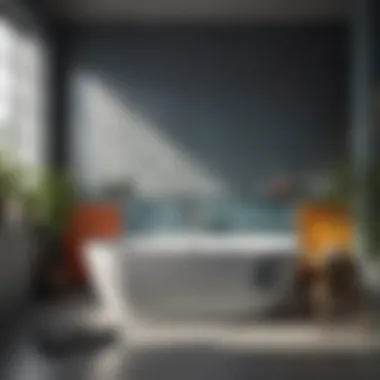
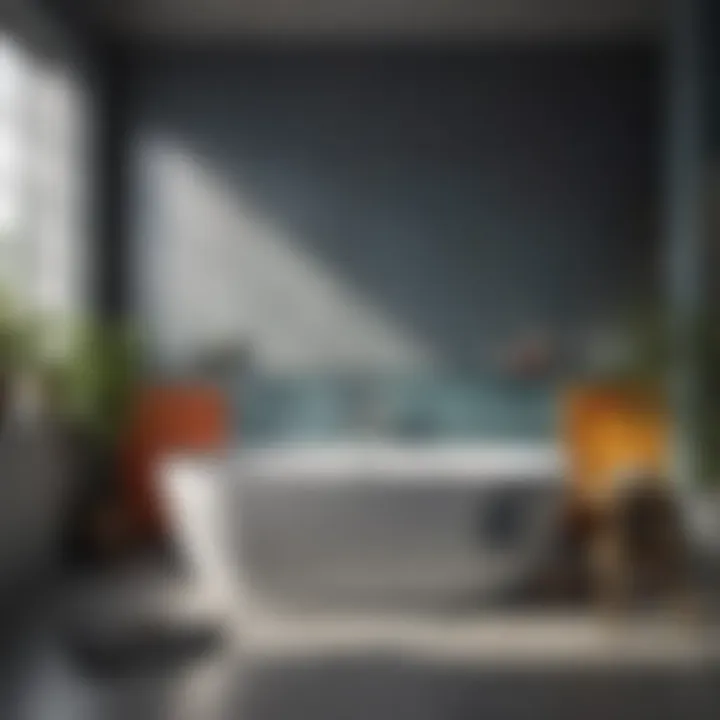
Acrylic Waterproof Paint
Acrylic waterproof paint is known for its versatility and quick-drying properties, making it ideal for bathroom applications. This type of paint is water-based, which means it holds up well against moisture while being easy to clean with just soap and water. Furthermore, acrylic paints also provide excellent color retention and can finish with a smooth, even look.
An important characteristic of acrylic paint is its flexibility. It can expand and contract with temperature variations, which is essential in a bathroom environment where the conditions may change rapidly due to water use.
Latex Waterproof Paint
Latex waterproof paint works well in high-humidity areas, offering a smart alternative for bath spaces. Like acrylics, these paints are water-based but tend to be thicker and more durable. They resist fading and are easy to maintain, allowing homeowners to keep their bathrooms looking fresh with minimal effort.
One key benefit of latex paints is their low levels of volatile organic compounds (VOCs), which means they are less harmful to indoor air quality. If you’re looking to strike a balance between performance and health considerations in your home, latex waterproof paint is a compelling choice. However, it may require a more extended drying period compared to acrylics.
Oil-Based Waterproof Paint
Oil-based waterproof paints are renowned for their robust qualities. These paints create a thick, protective layer against moisture, making them particularly suitable for areas prone to splashes and spills. Their composition provides exceptional durability and resistance to scratching, ensuring a flawless finish for longer periods.
However, it's important to note that oil-based paints typically have higher VOC levels and can emit strong odors during application, which can be a concern for some households. The drying time is another disadvantage; it usually requires more patience as it takes longer to cure compared to its water-based counterparts.
Specialty Waterproof Paints
Specialty waterproof paints cater to specific needs in bathroom settings, typically excelling in addressing challenges posed by mold and moisture. Within this category, we can further explore two subtypes that stand out.
Anti-Mold and Mildew Paints
Anti-mold and mildew paints are specially formulated to prevent the growth of bacteria, mold, and mildew, which thrive in moist settings. This specific aspect is crucial in bathrooms, where moisture is an everyday reality. These paints can contain fungicides that impede the reproduction of mold spores, ultimately maintaining a hygienic environment.
The primary advantage of these paints is their long-lasting effectiveness, ensuring that a bathroom not only looks good but also remains sanitary. However, one should be cautious about their potential harsh chemical contents and opt for brands that focus on safety and lower toxicity.
Moisture Barrier Paints
Moisture barrier paints are designed to seal off surfaces from moisture infiltration. This can be especially useful in bathrooms that are subject to high humidity or even water exposure. What makes these paints valuable is their capacity to create an impermeable barrier, helping to protect the underlying materials from damage.
The unique feature of moisture barrier paints is their ability to be applied to damp surfaces, which can simplify application without requiring a lengthy waiting period for complete drying. The main downside is that they can sometimes have a limited color range, which may restrict some decor choices.
Evaluating Waterproof Paint Options
In the realm of bathroom renovations, understanding the nuances of waterproof paint options is crucial. The right paint can be the difference between a beautifully painted bathroom that lasts and one that deteriorates in no time due to humidity and moisture. Evaluating these options involves assessing various factors that impact both the aesthetic appeal and longevity of your investment.
Key Factors to Consider
Durability and Longevity
When diving into the world of waterproof paints, durability steals the spotlight. A key characteristic here is the ability to withstand the constant onslaught of moisture without peeling or blistering. This is particularly beneficial in a bathroom, where high humidity levels are the norm.
A unique feature of durable waterproof paint is its formulation, often involving mildewcide or antibacterial properties. These additions not only prolong the life of the paint but also keep mold and mildew at bay, which can lead to health issues and unsightly appearances. On the downside, some highly durable paints may come with a higher price tag, which can be a deterrent for homeowners on a tight budget.
Ease of Application
Next up is ease of application. This factor can save time and attract DIY enthusiasts who want to undertake the project themselves. Many modern waterproof paints are designed for hassle-free application, often requiring just a single coat in some cases. A noteworthy feature here is that they can be applied over existing paint, providing an extra layer of flexibility for renovations.
However, the downside could be related to drying times, as some products may require longer curing periods, which could disrupt your timeline. Balancing ease of application with the right product choice ensures you don't end up with a subpar finish due to rushed work.
Color Options and Finishes
Your choice of paint color directly impacts the overall feel of the bathroom. Why is this characteristic important? Because color can either make a space feel larger or cozier, depending on the desired atmosphere. Many waterproof paints offer a variety of colors and finishes, ranging from matte to glossy, giving homeowners the flexibility to express their personal style.
A unique aspect to consider is how different finishes react in moisture situations. For instance, a glossy finish can provide easy cleaning, while matte might hide imperfections better. But, it’s worth discussing potential drawbacks—sometimes a wide array of options can lead to decision fatigue, causing delays in the project.
Brand Comparisons
High-Performance Brands
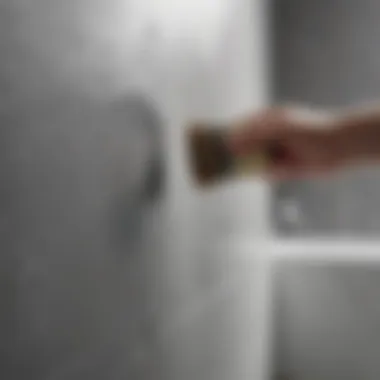
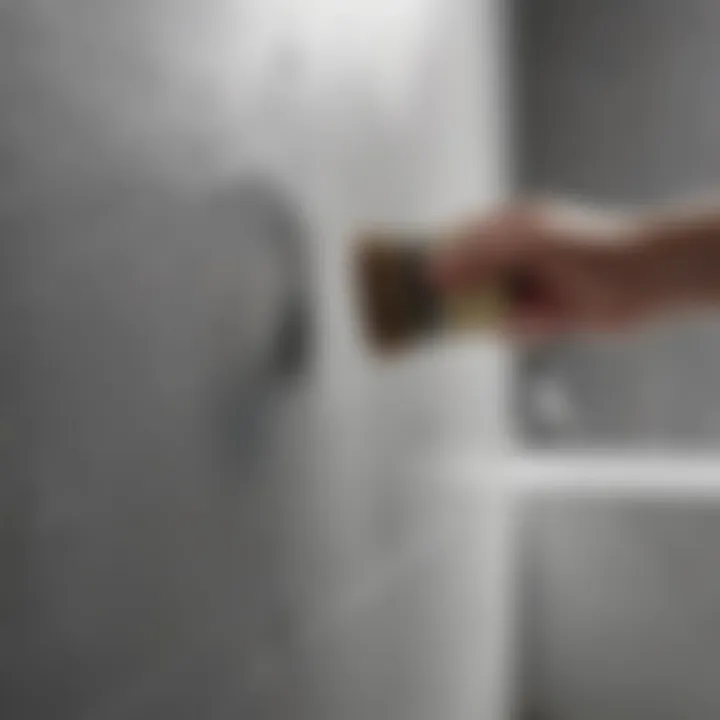
High-performance brands often set the bar in the waterproof paint market. Their formulations are usually geared to withstand serious abuse from moisture while offering vibrant colors. The hallmark of such brands is a proven track record in similar conditions, which speaks volumes to potential buyers. Often, they come with warranties that ensure satisfaction.
However, you might question the investment. While these brands excel in performance, their prices can be hefty, making them less accessible for some homeowners. Ultimately, balancing performance with cost-effectiveness is an essential step in making the right choice.
Budget-Friendly Options
On the flip side, budget-friendly options can attract homeowners looking for functional, yet aesthetically pleasing solutions. These paints may not cost an arm and a leg, and they’re often still effective in providing waterproof protection. Many brands have carved out a niche by offering decent quality at a lower price.
That being said, they can sometimes lack the longevity and finish quality found in higher-priced counterparts. Homeowners may need to factor in that a cheaper product might require more frequent application, potentially negating any initial savings.
In summary, evaluating waterproof paint options requires a careful balancing act of durability, ease of application, and design choices, alongside considerations of cost and brand reputation. Finding the right combination ensures that your bathroom remains not just functional, but aesthetically pleasing for years to come.
Application Techniques for Optimal Results
Successfully applying waterproof paint in bathrooms is not just about slapping on a coat and calling it a day. For the best outcomes, understanding application techniques is crucial. This section dives into why getting it right is essential, especially in the moisture-laden environment of a bathroom.
Proper application can significantly enhance the adhesion of paint, ensuring that it withstands the daily barrage of humidity while keeping surfaces looking fresh. Beyond mere aesthetics, the way you prepare and apply waterproof paint can also make the difference between a lasting finish and a peeling nightmare.
Surface Preparation
Cleaning and Priming Surfaces
Before any paint hits the walls, surface preparation must be as thorough as a chef cleaning their utensils before cooking. Cleaning and priming surfaces are key steps that contribute to the overall durability and performance of waterproof paint. This process involves scraping away dirt, soap scum, and any signs of old paint. A clean surface helps the new coat adhere better, like a magnet to steel.
Priming also seals the porous surfaces, preventing the paint from soaking in too much and helping to create a uniform finish. It’s a beneficial and perhaps even essential part of the process. The unique feature of priming is its ability to act as a barrier, ensuring that moisture doesn’t prematurely damage your paint job.
However, not all primers are equal. Some options can be costly, and choosing the wrong type might lead to unexpected issues later on. Using a primer designed specifically for wet environments, though, yields substantial long-term advantages in terms of durability and maintenance.
Repairing Existing Damage
When planning to paint, one must not overlook repairing existing damage. Cracked or peeling areas need attention before the first brushstroke. Repairing existing damage is like tackling the foundation before building a house – it’s simply non-negotiable.
This step ensures a smooth surface for the waterproof paint, minimizing the risk of future peeling or flaking. It’s not just a cosmetic choice; it’s an investment in longevity. The unique feature in addressing damage is that it fosters stronger adhesion and an even distribution of paint, which ultimately leads to a more visually appealing finish.
However, it can be time-consuming and might require multiple products to address various issues, which could frustrate some DIY enthusiasts. But the benefits of taking this seriously often outweigh the initial hassle. A well-prepared surface pays dividends, saving both time and money in the future.
Application Methods
Brushing vs. Rolling
When it comes to applying waterproof paint, choosing between brushing and rolling can be a head-scratcher. Both methods have their merits, but they serve different purposes in the application process. Brushing is ideal for edges and intricate areas where control is paramount. It allows for precise application without leaving puddles of paint that rollers might miss. However, it can require more time and effort, often leading to a sore wrist if you’re not used to it.
On the other hand, rolling covers larger areas faster, making it a popular choice for wall applications. It helps you achieve a smooth and even coat, saving time in larger bathrooms. The unique feature here is that rolling can produce a uniform texture that’s often hard to get with a brush alone.
One downside is that a roller can leave behind excessive paint in corners and crevices if not handled properly. Therefore, some find a hybrid approach of both methods the best means to achieve an optimal outcome.
Spray Application Considerations
Spraying paint can be exhilarating, like using a magic wand to create a beautiful finish. However, there are critical considerations. Spray application delivers a fine mist that clings effortlessly to surfaces, ensuring an even coat across both large and small areas. It’s especially useful if you’re painting intricate designs or heavy texture on walls.
One key characteristic is speed; a sprayer can cut down application time down to mere minutes in spacious areas. Yet, mastering the technique takes some practice. If not done correctly, overspray can lead to wastage and could make a mess everywhere.
Moreover, proper ventilation is a must with spray paint; the fine mist can linger in the air, which is something to consider. Despite these concerns, many professionals prefer spray application for its efficiency and finish quality.
Drying and Curing Times
Last but not least is understanding drying and curing times, which can seriously affect your project schedule. Drying time refers to how long it takes for the paint to become dry to the touch, while curing time is the period it takes for the paint to reach its maximum hardness and adhesion. These timelines are not merely numbers on a label, they significantly impact whether or not your paint job will succeed or go south.
Generally, waterproof paints dry faster than traditional paints, but different products can have widely varying drying times based on their chemical composition. So, while it may be tempting to jump back into your newly painted space, patience is crucial here. Rushing this step can lead to smudges or a finish that won’t stand up to the demanding bathroom environment.
"The time taken for paint to dry, though seemingly bothersome, is the crucial pause before the flourish – so don’t skimp on it."
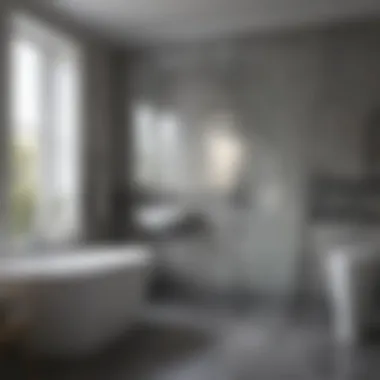

In summary, mastering application techniques can make all the difference in the longevity and appeal of your bathroom’s waterproof paint. From thorough preparation to selecting the best application method, taking the time to understand these processes offers you a smoother path to a beautiful and resilient bathroom finish.
Maintenance and Care for Waterproof Paint
When investing in waterproof paint for your bathroom, it's not just about the initial application; maintenance and care are crucial for ensuring the longevity and effectiveness of that investment. Regular upkeep helps maintain the paint's sealing properties against moisture, safeguarding your walls from potential damage. Let’s delve into how to keep your waterproof paint in top-notch shape.
Cleaning Techniques
Cleaning waterproof paint may not sound particularly complex, but there are some best practices to follow. For starters, it's advisable to use a gentle non-abrasive cleaner. Abrasive sponges or harsh chemicals can scratch the paint finish, compromising its integrity. Warm soapy water can effectively remove dirt without damaging the surface.
- Use Soft Cloths: Opt for microfiber cloths or sponges when wiping surfaces. They effectively lift dirt while being gentle on paint.
- Spot Testing: Always test any cleaning solution on a hidden part of the wall before applying it broadly. This recommendation helps ensure there are no adverse reactions.
- Frequency: Making a habit of cleaning these painted surfaces every month can help prevent buildup and keep them looking fresh.
Regular Inspections
Identifying Signs of Wear
One significant aspect of maintaining waterproof paint is regularly checking for signs of wear. This preventative measure is essential as it can prevent minor issues from snowballing into costly repairs down the road.
- Key Characteristic: Common signs include peeling, fading, or bubbling paint. Watching for these indicators can help you take action before it escalates.
- Why It's Beneficial: Keeping a close eye on these elements allows for early intervention which can save money in long term. Addressing issues promptly ensures that your bathroom remains a bastion against moisture.
- Unique Features: The crucial aspect here is noticing that the surface retains its sheen; loss of gloss can be an early sign that the paint is losing its waterproofing capabilities. Identifying issues early generally means more straightforward repairs and less hassle in the long run.
Addressing Minor Repairs
When you spot minor issues, addressing them right away is key to maintaining the integrity of your waterproof paint. Catching small problems like cracks or peeling can not only extend the life of the paint but also improve the overall appearance of your bathroom.
- Key Characteristic: Using the same paint for touch-ups is recommended. This approach ensures a uniform look, blending seamlessly into the wider painted area.
- Why It's Popular: Minor repairs can significantly enhance your bathroom’s aesthetic and prevent larger issues down the line, allowing for a fresh look without undergoing full repainting.
- Unique Feature: A strategic approach to touch-ups can also add further layers of waterproof protection, effectively reinforcing the paint's moisture defense properties without intensive labor.
"Regular maintenance and timely repairs can keep your waterproof paint looking great and safeguard your bathrooms from moisture damage, saving you time and money in the long run."
In sum, integrating these maintenance routines and cleaning techniques into your schedule is not only smart but necessary for preserving the waterproof qualities of your paint. With consistent attention and care, you can enjoy a beautifully maintained bathroom for many years.
Future Trends in Bathroom Waterproofing
When it comes to modern bathrooms, waterproofing is not just a trend but a necessity. Understanding the future trends in bathroom waterproofing, especially in relation to waterproof paint, helps homeowners and designers make informed choices. This focus is particularly important as the demand for aesthetic appeal intertwines with functional durability. As bathrooms become not only essential spaces but also personal retreats, it’s integral to explore what innovations lie ahead that will enhance both the performance and visual charm of these areas.
Innovations in Paint Technology
The painted walls in bathrooms are undergoing a revolution that matches the changing times. Innovations in paint technology encompass advanced formulas specifically designed to resist the rigors of moisture and humidity. Noteworthy developments include:
- Self-Cleaning Paints: This technology mimics the lotus leaf effect, where surfaces repel water and dirt. This not only keeps the walls fresh longer but reduces maintenance efforts drastically.
- Antimicrobial Paints: These are infused with agents that actively combat mold and mildew growth. As a result, they prolong the life of the paint and keep the interiors healthier, making them a wise choice for bathroom environments.
- Smart Paints: This is where technology meets creativity. Some new paints can change color in response to temperature or light, which could add a dynamic element to bathroom design. Homeowners could adjust the mood of the room instantly!
As paint technology evolves, it brings more options and possibilities to transform your bathroom beyond mere color.
Sustainability in Waterproof Paints
Sustainability has become a watchword for modern consumers, and the realm of waterproof paints is no exception. In the past few years, there’s been a noticeable shift towards eco-friendly options that do not compromise on performance or aesthetics.
- Low-VOC and VOC-Free Paints: Traditional paints can emit harmful volatile organic compounds (VOCs) which are detrimental to both health and the environment. Newer formulations are prioritizing air quality, making them safer for home environments while also being friendlier to the planet.
- Recycled Materials: Some waterproof paints now incorporate recycled ingredients. This reduces waste and demonstrates a significant step towards sustainability in the paint industry.
- Energy-Efficient Paints: Future trends suggest the potential for paints that reflect heat, leading to cooler living spaces. This not only provides comfort but could also reduce energy bills.
The focus on sustainability in waterproof paints signals a shift not just for those looking to enhance their bathrooms aesthetically but also for those who want to do so responsibly. As homeowners become more conscious of their choices, selecting environmentally friendly paints could soon be the norm rather than an exception.
"Embracing innovations and sustainability in bathroom waterproofing not only enhances space aesthetics but also safeguards our health and environment."
In summary, the future of bathroom waterproofing is bright, offering a blending of technology and sustainability. This allows homeowners to create beautiful, functional, and environmentally conscious spaces.
The End
In wrapping up the discussion on waterproof paint for bathrooms, it's crucial to recognize its significance in improving both functionality and aesthetics. Bathrooms are uniquely positioned to face humidity and moisture challenges; hence, the right paint can make all the difference in safeguarding surfaces while enhancing the area visually.
One of the key takeaways from the various sections is that the bathroom environment requires specialized solutions. Waterproof paint serves not just as a decorative application but as a protective barrier against water damage, mold, and mildew, thus ensuring that your sanctuary remains fresh and inviting. Without this essential element, you risk compromising the overall integrity of your decor.
Consider how, over time, improper choices in paint can lead to peeling walls, unsightly stains, and extensive repair costs. Conversely, choosing the right type of waterproof paint tailored to your specific needs can prolong the life of your bathroom surfaces and maintain their pristine nature.
Key elements to highlight include:
- Variety of Paints: There are multiple types of waterproof paints available, each with its strengths and weaknesses. Understanding these can guide homeowners in making informed choices.
- Application Techniques: Proper application is as important as selecting the right product. As we've detailed, preparation and execution heavily influence the longevity of the applied paint.
- Maintenance Practices: Regular maintenance, like cleaning and inspections, plays a pivotal role in extending the life of painted surfaces.
"A wise investment in waterproof paint may very well save you further expenses down the line from repairs and replacements."
As trends evolve, sustainability and innovation will dictate future selections of bathroom waterproof paints. Homeowners should continue to stay informed about advancements in technology that promise both functionality and environmental consciousness.















